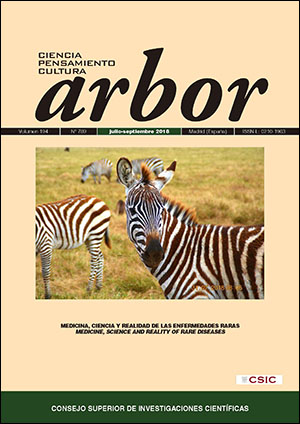Internal medicine and rare diseases.Child-adult transition
DOI:
https://doi.org/10.3989/arbor.2018.789n3002Keywords:
rare diseases, inherited metabolic diseases, inborn errors of metabolism, child-adult transition in inborn errors of metabolismAbstract
Most rare diseases (RD) are genetically based, occur with very different symptoms and may cause a different degree of disability, especially inborn errors of metabolism (IEM). The clinical transition process of a patient with a RD reaching adulthood aims to ensure uninterrupted, coordinated and psychologically-appropriate health care through multidisciplinary expert units (EU). The specialist in Internal Medicine has a central role, along with Nutrition and Dietetics, a specialized ECM laboratory, and other specialists (Neurology, Clinical Genetics, Pharmacy, Ophthalmology, Obstetrics, Psychiatry, Nursing, Social Work, with the support of pediatricians experienced in ECM). EU should organize the overall care, develop clinical guidelines for diagnosis, follow-up and treatment, adapt Pharmacy services, create patient registers, establish relationships with patients’ associations, develop a scientific training program, establish international partnerships, facilitate collaboration with the Pharmaceutical Industry and have its own research activity.
Downloads
References
Blum, R. W., Garell, D., Hodgman, C. H., Jorissen, T. W., Okinow, N. A., Orr, D. P. y Slap, G. B. (1993). Transition from Child- Centered to Adult Health-Care Systems for Adolescents with Chronic Conditions. A Position Paper of the Society for Adolescent Medicine. Journal of Adolescent Health, 14 (7), pp. 570-576. https://doi.org/10.1016/1054-139X(93)90143-D
Buchbinder, N., Berger, M., Robert, A. y Vannier, J. P. (2011). Difficult transitions from paediatric to adult care in type 1 Gaucher disease. Archives de Pédiatrie. Organe officiel de la Societé Française de Pédiatrie, 18 (2), pp. 165-169. https://doi.org/10.1016/j.arcped.2010.11.013 PMid:21194904
Cardellach, F. y Vilardell, M. (2006). Hacia el perfil de médico que necesita la comunidad. Medicina Clínica, 127 (4), pp. 136- 138. https://doi.org/10.1157/13090379
Grau, J. M. y Cardellach, F. (2010). Enfermedades raras y el especialista en Medicina Interna. Medicina Clínica, 134 (12), pp. 540-541. https://doi.org/10.1016/j.medcli.2010.01.021 PMid:20219217
Izquierdo Martínez, M. y Avellaneda Fernández, A. (2003). Enfoque multidisciplinario de las enfermedades raras: un nuevo reto para un nuevo siglo. Medicina Clínica, 121 (8), pp. 299-303. https://doi.org/10.1016/S0025-7753(03)73924-4
Kossoff, E. H., Veggiotti, P., Genton, P. y Desguerre, I. (2014). Transition for patients with epilepsy due to metabolic and mitochondrial disorders. Epilepsia, 55 (supl. 3), pp. 37-40. https://doi.org/10.1111/epi.12709 PMid:25209085
Lee, P. J. (2002). Growing older: the adult metabolic clinic. Journal of Inherited Metabolic Disease, 25 (3), pp. 252-260. https://doi.org/10.1023/A:1015602601091
Mütze, U., Roth, A., Weigel, J. F. W., Beblo, S., Baerwald, C. G., Bührdel, P. y Kiess, W. (2011). Transition of young adults with phenylketonuria from pediatric to adult care. Journal of Inherited Metabolic Disease, 34 (3), pp. 701-709. https://doi.org/10.1007/s10545-011-9284-x PMid:21305352
Palau, F. (2010). Enfermedades raras, un paradigma emergente en la medicina del siglo XXI. Medicina Clínica, 134 (4), pp. 161-168. https://doi.org/10.1016/j.medcli.2009.06.038 PMid:19767033
<b>Disposiciones oficiales</b>
Orden SCO/227/2007 de 24 de enero, por la que se aprueba y publica el programa formativo de la especialidad de medicina interna. Boletín Oficial del Estado nº 33 de 7 de febrero de 2007, pp. 5755- 5759. Disponible en: https://www.boe. es/boe/dias/2007/02/07/pdfs/A05755- 05759.pdf
<b>Recursos en línea</b>
CatSalut. Servei Català de la Salut. Instrucció 12/2014, de 15 d'octubre de 2014. Desarrollo e implantación del modelo de atención a las enfermedades minoritarias (EM) en Catalu-a. Ordenación de las unidades expertas clínicas para EM o grupos temáticos de EM. [En línea]. Disponible en: http://catsalut.gencat. cat/web/.content/minisite/catsalut/ proveidors_professionals/normatives_instruccions/any_2014/instruccio_12_2014/instruccio_12_2014.pdf
Sociedad Española de Medicina Interna (SEMI). [En línea]. Disponible en: http:// www.fesemi.org/
Published
How to Cite
Issue
Section
License
Copyright (c) 2018 Consejo Superior de Investigaciones Científicas (CSIC)

This work is licensed under a Creative Commons Attribution 4.0 International License.
© CSIC. Manuscripts published in both the printed and online versions of this Journal are the property of Consejo Superior de Investigaciones Científicas, and quoting this source is a requirement for any partial or full reproduction.All contents of this electronic edition, except where otherwise noted, are distributed under a “Creative Commons Attribution 4.0 International” (CC BY 4.0) License. You may read here the basic information and the legal text of the license. The indication of the CC BY 4.0 License must be expressly stated in this way when necessary.
Self-archiving in repositories, personal webpages or similar, of any version other than the published by the Editor, is not allowed.














